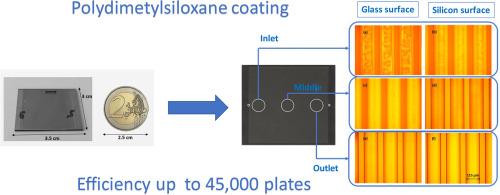太空探索专用微型芯片气相色谱柱:固定相涂层、设置优化和色谱柱性能评估
IF 3.2
引用次数: 0
摘要
这项工作是专门设计用于太空探索的气相色谱微柱项目的第一部分。特别是,这项研究探索了硅/玻璃微芯片气相色谱柱的功能化和表征,这种微芯片气相色谱柱设计成内部横截面为方形的蛇形通道。这种微型色谱柱可通过带有可拆卸毛细管接头的坚固流体歧管与传统气相色谱仪连接,或在用于太空探索的原型仪器中实施。首先,对台式气相色谱仪系统的进样器内衬体积、毛细管连接内径(I.D.)和检测数据频率进行了优化,以确保对色谱柱效率进行最佳评估。结果发现,内径为 100 μm 的连接毛细管、内径为 1.2 mm 的内衬和 100 Hz 的检测采集频率是最佳的设置和参数。此外,还降低了固定相的涂布速度,使色谱柱的效率提高了 100%。然后,比较了方形截面毛细管色谱柱与传统圆形截面色谱柱的性能。圆形和方形内部横截面的涂层效率分别为 55% 和 42%,这表明方形横截面对色谱柱的性能影响不大。在同一生产批次的不同微芯片上涂覆了 0.032 至 0.260 µm 不同厚度的固定相薄膜,以评估薄膜厚度对色谱性能的影响。微芯片的性能通过戈莱图进行评估,部分微芯片还通过光学显微镜进行了研究。结果表明,微芯片色谱柱的效率和保留能力与薄膜厚度密切相关(最薄的薄膜厚度为 9,000 板/米-1,k=0.12;最厚的薄膜厚度为 4,000 板/米-1,k=0.93)。最后,通过生产三个完全相同的微芯片,验证了镀膜工艺的可重复性,理论板平均数量的 RSD 为 4.8%。本文章由计算机程序翻译,如有差异,请以英文原文为准。

Microchip gas chromatographic columns dedicated for space exploration: Stationary phase coating, setup optimization and evaluation of column performances
This work is the first part of a project aiming to specifically design gas chromatographic microcolumns for space exploration. In particular, this study explored the functionalization and characterization of silicon/glass microchip gas chromatographic columns designed with a serpentine-shaped channel having an internal square cross-section. This microcolumn can be connected using a robust fluidic manifold with removable capillary connections to a conventional gas chromatograph or implemented in a prototype instrument for space exploration. First, benchtop gas chromatographic system was optimized in terms of injector liner volume, internal diameter (I.D.) of the capillary connections and data frequency of detection to ensure an optimal evaluation of column efficiency. Junction capillaries of 100 μm I.D., a liner of 1.2 mm I.D. and a detection acquisition frequency of 100 Hz were found to be the optimal set-up and parameters. Moreover, the stationary phase coating velocity was slowed-down to increase column efficiency by 100 %. Then, the performances of a square cross-section capillary column were compared with those of a conventional circular cross-section column. The coating efficiencies were estimated at 55 % and 42 % for circular and square internal cross-section geometries respectively, demonstrating that the square section geometry did not affect significantly the column performances. Stationary phase films of different thicknesses, from 0.032 to 0.260 µm, were coated on different microchips of the same production batch to assess the influence of film thickness on the chromatographic performances. Microchips performance was evaluated through Golay's plots, and some of the microchips were also studied by optical microscopy. The efficiency and retention capacity of our microchip column is shown to be highly dependent on the film thickness (9,000 plates.m-1 with k = 0.12 for the thinnest film and up to almost 4,000 plates.m-1 with k = 0.93 for the thickest film). Finally, the coating process repeatability was validated by producing three identical microchips with RSD of 4.8 % for the average number of theoretical plates.
求助全文
通过发布文献求助,成功后即可免费获取论文全文。
去求助
来源期刊

Journal of chromatography open
Analytical Chemistry
CiteScore
2.50
自引率
0.00%
发文量
0
审稿时长
50 days
 求助内容:
求助内容: 应助结果提醒方式:
应助结果提醒方式:


